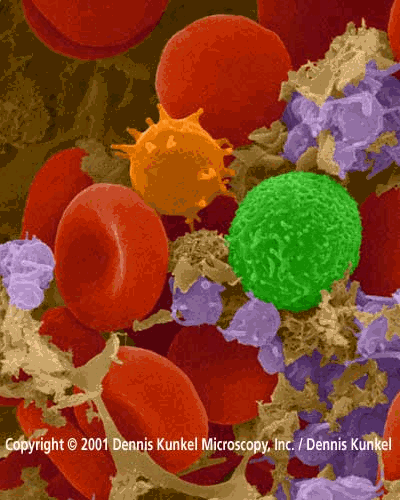WHATís UP (with Jane) DOC??????: An Immunology Laboratory Exercise

Introduction
The function of the immune system is to protect us from infection by a pathogen. First the system has to recognize the pathogen as foreign. Then it must activate non-specific (innate) and specific (acquired) immune responses to remove the pathogen. Besides pathogens, our immune system encounters all sorts of other molecules in the environment that are foreign to our body, but not infectious and not harmful to our health. These substances (allergens) do not activate the immune systems of most people. But some peopleís immune systems do respond to an allergen, and they develop an immune response to it, just as they might to a foreign antigen. Their immune system overreacts, and the person may feel sick, as if their body is fighting off an infection, even though there isnít one. We often describe these individual as having an allergy or hypersensitivity.
Today youíll play "doctor" and diagnose the condition of your "patient" Jane Smith. In the process youíll learn about how the immune system works and actually perform two immunological tests that a doctor might order to help make this diagnosis.
Janeís History
Jane Smith is a 16 year-old high school junior who is highly motivated as an athlete and academic student. She has had a history of good health until this past semester. Her life style hasn't altered too much in terms of eating habits, hobbies or time for sports and school. But lately, sheís so tired that she collapses in bed after coming home, unable to complete her homework. Sheís having trouble sleeping at night, so that during the day, she has trouble paying attention in class and is afraid her grades will suffer, putting her college plans in jeopardy. Jane has also noticed that she is short of breath on occasion and rather "stuffed up" some evenings, especially after she comes home from her new job, babysitting next door at the Haynesís, which she does 3 evenings a week. She doesnít have a fever. She reported to the school nurse twice this week, complaining of a bad cold. At her second visit, the nurse suggested that she should see you, her pediatrician, since it seemed that there hadnít been any improvement in how she was feeling. The nurse suggested that maybe she didnít have a cold but that she might have an allergy. But she has a pet cat, Mildred, and isnít allergic to her, and there arenít any cats at the Haynesís, just a dog and a parrot. So she really doesnít think she has an allergy.
Results of Janeís clinical examination
Jane is a 16 year-old female, in no acute distress. Her vital signs are: Temperature 98.4 degrees, pulse 72, blood pressure 116/74, respiratory rate 16. Jane has dark circles under both her eyes. Her sclera (the whites of her eyes) are red, but there is no discharge. Her ears are normal. Her nasal mucosa are pale, with a clear discharge, suggestive of allergies. Her mouth is normal, and her tonsils arenít enlarged. There is no tenderness over her sinuses. Her neck is supple, with no swollen lymph nodes. Her heartbeat is regular, without any murmurs. Her lungs showed scattered wheezes when she breathed out. Her abdomen is soft, with no masses or organ enlargement. No rashes were present.
You order a routine set of tests to evaluate her overall health. Decide whether the results are normal, and record your evaluation for each test in the column marked "Your Evaluation".
|
INVESTIGATION |
NORMAL RANGE |
LAB RESULT |
YOUR EVALUATION |
|
Hemoglobin (g/L) |
11.5-16.0 |
12.1 |
|
|
White cell count (x 109/L) |
4.0-11.0 |
6.0 |
|
|
Sinus (Nasal cavity) CT |
Clear |
No evidence of sinusitis (sinus infection) |
|
|
Chest X-ray |
Clear |
Normal (clear) |
|
|
Pulmonary function testing |
Normal |
Mild obstruction, suggestive of reactive airway disease (asthma) |
Hemoglobin Ė
if levels are <12.0 g/dL, patient may have anemiaWhite cell count -
represents the sum of the counts of granular WBCs (neutrophils, basophils and eosinophils), lymphocytes, and monocytes. Their numbers may vary depending on the health of an individual. For example, when there is infection or leukemia the numbers may become very high.Sinus (Nasal cavity) CT Ė
computer tomography (CT) scan that uses X-rays to image the air-filled cavities in the frontal bones on the skull that are lined with a mucous membrane.Pulmonary function testing Ė refers to a broad range of tests that measure how well the lungs take in and exhale air and how efficiently they transfer oxygen into the blood.
Janeís history, physical exam, and laboratory testing were most suggestive of persistent allergies, leading to watery, itchy eyes, runny nose, sneezing, and asthma. You believe that if you can control her allergies, you can make her feel much better. First, you need to confirm that she does indeed have allergies and find out what she is allergic to, so that you can both advise her on environmental steps she can take to avoid triggering her allergies, as well as treat them. Since IgE antibodies are elevated in patients with allergies, you will perform an
ELISA test to detect and quantitate these antibodies. If the ELISA is positive, you will perform a Western Blot to determine the antigens triggering her allergies.

1. What steps can Jane take to prevent exposure to the allergen(s)?
2) How would you treat Janeís allergic symptoms, and why and how would these treatments work?